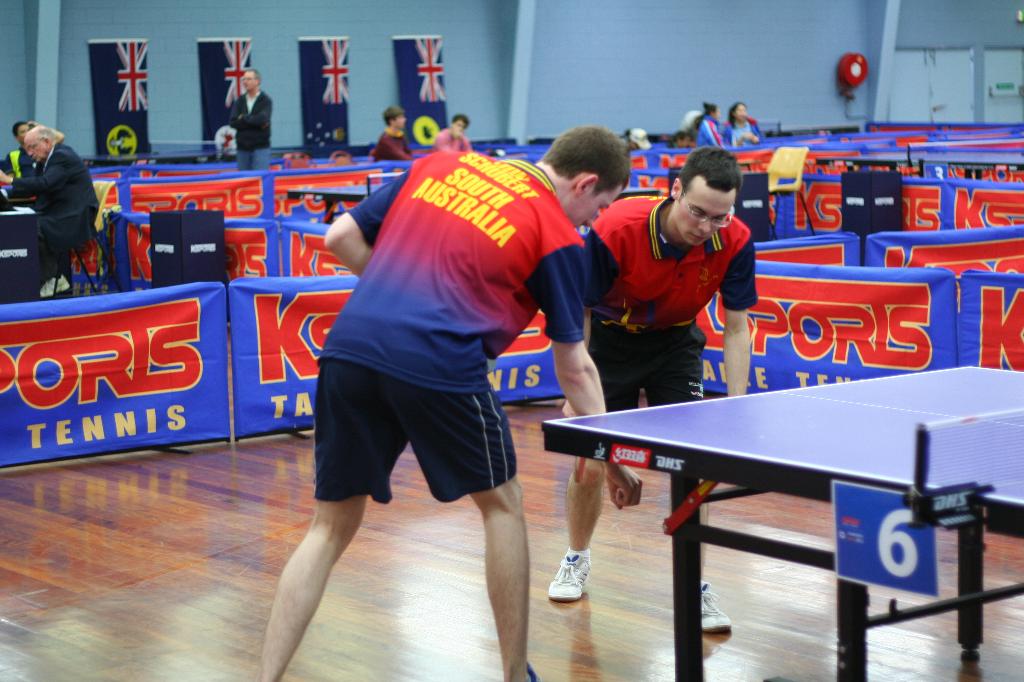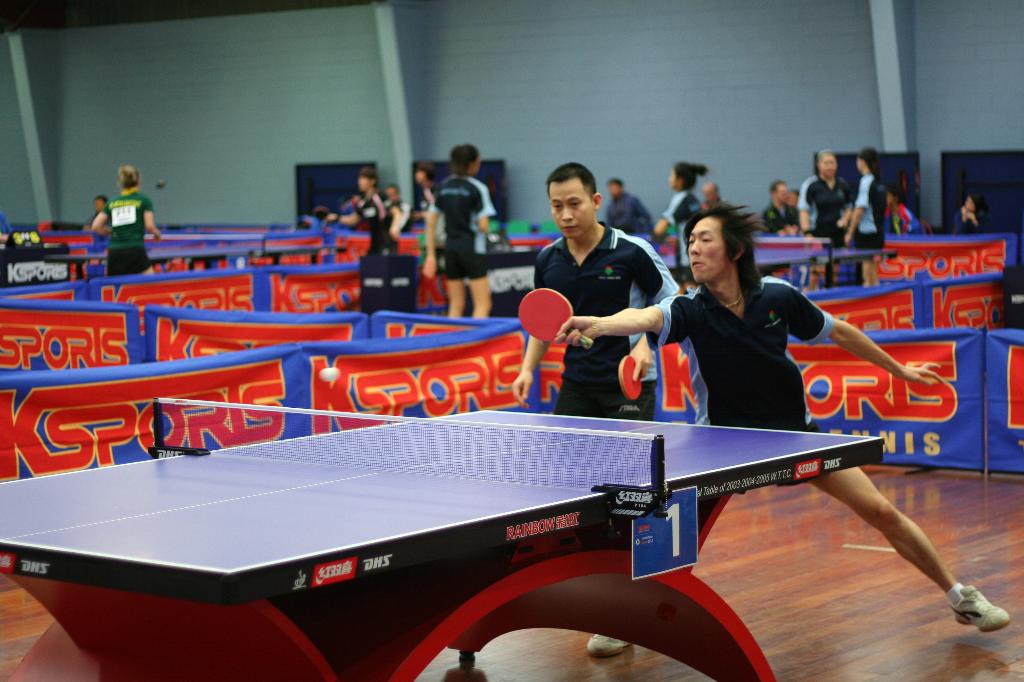Becoming a Dynamic Duo
Do you like to play doubles? Most ping-pong players enjoy a good game of doubles now and again. Playing and winning in doubles competition can be just as rewarding and fun as singles play – after all, there’s two of you to share the glory and celebrate!
But most articles written about table tennis tactics and strategies tend to focus on the singles side of competition, while doubles play tends to be treated as afterthought. There are some important differences between the tactics used for doubles play when compared to singles, so let’s have a look at the basics of playing doubles well.
It Takes Two
I have often seen a doubles team of lesser singles players take on and beat a combination of two stronger singles players. The reason? Just like the old saying, a champion team will beat a team of champions. Two weaker players that know each other’s game and play to support each other can be a tougher team to beat than two strong players that don’t work well togther. There are also some players who are known as excellent doubles players, simply because they know and apply many of the tactics mentioned below. So if you can understand and use these tips, you should be well on your way to becoming a much better doubles player, regardless of who you partner with.
Doubles Serving Tips and Tactics
-
- In doubles, you have to serve diagonally to your opponent, from your right hand half of the court to your opponents’ right hand half of the court. This reduces the amount of deception you can get from placing the ball well, and allows most opponents to cover the whole half court with either their forehand or backhand side, virtually eliminating the strategy of aiming at their playing elbow. This in turn lowers the effectiveness of longer serves, so most of the serves you perform in doubles should be double bounce serves that bounce low over the net and are difficult to attack.
- When serving, it is important to remember that it is your partner, not you, who has to make the third stroke. In order to improve your partner’s chances of making a good third ball attack, you should try to use services that will help set up your partner’s best attacks. For example, if your partner is not very good at attacking backspin balls, it doesn’t make a lot of sense to keep serving short backspin serves that force your opponents to push the ball back. Short, low topspin/sidespin or float serves that your opponent can flick (but not with too much power) will give your partner a better chance of making his attack.

- A series of signals can also be used when serving to allow your partner to know what serves you will be using, without your opponents overhearing. One simple method is to use two separate signals, the first to indicate the spin on the ball by pointing your finger in the direction the ball will go from your opponent’s racket (i.e. down for backspin, up for topspin, a fist for float, and point in any direction that your sidespin will take the ball). Then a second signal can be used for the length of the ball (i.e., pointing forward for a long serve, a fist for a normal double bounce serve, and point backwards for a very short serve).
- Whether the server or his partner makes the signals can depend on several things. Often if one player is much stronger than the other, the better player will tend to make the calls, using his experience to decide what to serve next. If both players are fairly similar in level, quite often the server will make the call, unless his partner has a plan specifically in mind, in which case the partner will signal his suggestions to the server.
Doubles Return of Serve Tips and Tactics
- I feel that the return of serve is often the key to being a winning doubles combination. Since the amount of deception is reduced when serving, a good receiver can often dominate the point, stopping his opponents from attacking and setting up his own partner’s attacks.
- When receiving, you can treat it much like returning serve in singles, with a couple of extra provisos in that you should be trying to force play towards the type of game your partner favors. If you are playing with a good forehand looper who can attack off topspin or backspin, then using mostly crosscourt returns will tend to make the line of play from your opponents go crosscourt towards your partners strong forehand. Likewise, if your partner is a strong blocker, then you should be trying to use flicks and loop returns more often than pushing returns short. If your partner is a little slow on his feet, avoid going to the wide angles too often, which will put his footwork under pressure, and concentrate your returns to the middle of the table more.
Doubles Rallies Tips and Tactics
- One of the most important parts of playing doubles is staying out of your partner’s way. Players in experienced doubles teams get to know where their partner will be at any given point in time, and so you don’t see them running into each other very often. Take notice of where your partner prefers to play from, and over time you will learn to automatically move out of the areas he likes to to hit the ball from.

Kiet Tran staying out of Xuyen Tran’s way. © Greg Letts - Playing the ball towards the person who just played the last stroke is often a good tactic, since it makes it that much harder for their partner to get an unhindered stroke. If one player is noticeably slower than the other, you might also want to play the ball wide to the slower partner to make him move, then play the next ball straight at him, so that he tends to get in his quicker partner’s way.
- Take notice of the playing strengths of your opponents. If your opponents consist of one good player and one weaker player, attack hard at the weaker player whenever possible. If you can’t make a good attack, then try tempting the weaker player to attack balls that are just a little too difficult for him to do successfully (a little too much spin, or into his playing elbow). At lower levels, you can often win a lot of easy points just by allowing the weaker player to attack and make mistakes. The motto is make the weaker player play the ball as often as you can.
- If you are a good player teamed up with a weaker player, your job is to make as many strong attacks as you can, so that your partner hopefully will get a weak return that he can handle easily. If you cannot attack strongly, you must place the ball with care, trying to make it difficult for your opponents to attack your partner. Make sure you are forcing play into the patterns that your partner can handle, so don’t push a lot of balls if your partner is weak at pushing, or flick a lot of balls if your partner does not have a good block to handle your opponents’ attacks.
- If you are a weaker player teamed up with a stronger player, your job is keep the ball on the table wherever possible, so that your better partner gets another chance to make a good attack. When the easy ball presents itself, you should attack it by all means though. But forget about trying to impress anyone by hitting balls that you normally wouldn’t try to hit. Just stick to doing what you can do, and being ready to hit any easy put-aways that have been set up by your partner.Return of serve is one area where a weaker player often tries to overdo it, attempting to place the ball too tightly, or even attack balls that he shouldn’t. Remember that you are playing with a much better partner, so you have to try to allow him to get into these rallies as often as possible, so he can use his skill. So just get the ball back somewhere on the table consistently, and if your partner gives you some advice on how to return the serve, make sure that you listen to what he is saying – he knows what he is talking about!Likewise when you are serving – you don’t need to make incredible serves, just keep them simple and error free, so that your partner can start trying to attack the third ball. If you are serving faults you are preventing your partner from using his expertise.
- Encourage your partner, rather than criticizing him. Nothing makes a person get tense faster than his partner giving him a hard time about his mistakes. Accept that both you and your partner are going to make some mistakes along the way, but as long as you are both following your overall strategy that’s fine. If your partner is making mistakes because he is trying to do something that is not part of your strategy, just remind him of what your plan is, and focus on both of you getting back to doing what you should be doing.
- If your partner is having a particularly bad day and is making a lot of mistakes, the question arises as to whether you should try to compensate for it. This usually means playing more aggressively, and taking more risks by trying to hit stronger attacks than normal, in the hopes of getting back into the game. This is not easy to do, so it is usually better to give your partner more time to get his game together, but if he continues to make errors, at some point it will be up to you to try to lift your own game up to try to win the match. Give your partner plenty of time to try to get back on track, but don’t wait until you are several match points down before starting to get aggressive! Also, make sure you let your partner know what you are going to try to do, so he can be ready for your more aggressive attitude and adjust his game accordingly.
OK – that’s it for now – time to go out and put these tips into practice!

